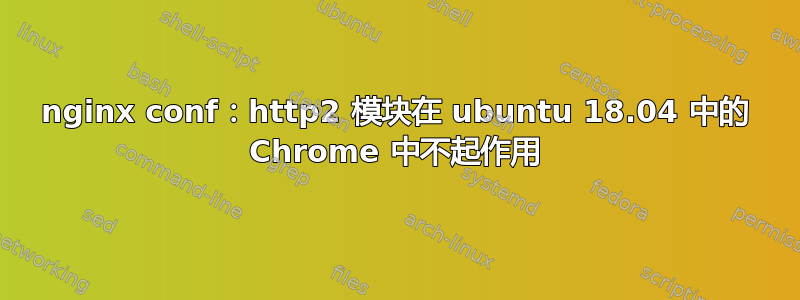
我正在尝试在全新的 Ubuntu 18.04 vps 上设置 nginx 中的 http2 模块。Http2 在 Firefox 中运行良好(我检查了响应标头)。一些第三方网站表明我的 http2 配置正常:
- https://tools.keycdn.com/http2-test
- https://www.ssllabs.com/ssltest/analyze.html?d=example.com(我在这个网站上得了 A+ 的评价)
但是当我尝试在 Chrome 上打开该网站时,它甚至无法打开(无法访问该网站),尽管在访问日志中(/var/log/nginx/access.log)我从 nginx 获得了一个“HTTP/2.0”200 响应,这表明 nginx 的行为好像一切正常。
从 curl 中我得到了这个答案:
$ curl -I https://example.com/
HTTP/1.1 200 OK
Server: nginx/1.14.0 (Ubuntu)
Date: Sun, 19 May 2019 13:20:33 GMT
Content-Type: text/html; charset=UTF-8
Connection: keep-alive
Vary: Accept-Encoding
X-Frame-Options: SAMEORIGIN
X-Content-Type-Options:: nosniff
X-XSS-Protection: 1;mode=block
Strict-Transport-Security: max-age=15768000
因此,不是 http2,但至少我可以用 curl 回退到 http1.1
因此,显然 http2 可以运行,但在 Chrome 中却不行(空白页),我不知道问题出在哪里。
如果忘记说,当我使用 Chrome 浏览页面时,错误日志中没有出现任何错误(/var/log/nginx/error.log),但是,有时,会出现与 ssl 相关的错误(这里是示例):
2019/05/19 14:53:33 [crit] 11931#11931: *639 SSL_do_handshake() failed (SSL: error:1417D102:SSL routines:tls_process_client_hello:unsupported protocol) while SSL handshaking, client: 64.41.200.103, server: 0.0.0.0:443
2019/05/19 14:56:34 [notice] 12616#12616: signal process started
2019/05/19 15:06:52 [notice] 12638#12638: signal process started
2019/05/19 15:08:48 [notice] 12647#12647: signal process started
2019/05/19 15:10:02 [notice] 12724#12724: signal process started
2019/05/19 15:10:07 [crit] 12725#12725: *706 SSL_do_handshake() failed (SSL: error:1417D102:SSL routines:tls_process_client_hello:unsupported protocol) while SSL handshaking, client: 91.107.64.185, server: 0.0.0.0:443
2019/05/19 15:10:07 [crit] 12725#12725: *707 SSL_do_handshake() failed (SSL: error:1417D18C:SSL routines:tls_process_client_hello:version too low) while SSL handshaking, client: 91.107.64.185, server: 0.0.0.0:443
2019/05/19 15:25:22 [crit] 12725#12725: *724 SSL_do_handshake() failed (SSL: error:1417D102:SSL routines:tls_process_client_hello:unsupported protocol) while SSL handshaking, client: 80.82.77.139, server: 0.0.0.0:443
2019/05/19 15:25:23 [crit] 12725#12725: *726 SSL_do_handshake() failed (SSL: error:1417D18C:SSL routines:tls_process_client_hello:version too low) while SSL handshaking, client: 80.82.77.139, server: 0.0.0.0:443
2019/05/19 15:25:23 [crit] 12725#12725: *727 SSL_do_handshake() failed (SSL: error:1417D102:SSL routines:tls_process_client_hello:unsupported protocol) while SSL handshaking, client: 80.82.77.139, server: 0.0.0.0:443
2019/05/19 15:25:27 [error] 12725#12725: *735 open() "/home/me/example.com/www/sitemap.xml" failed (2: No such file or directory), client: 80.82.77.139, server: example.com, request: "GET /sitemap.xml HTTP/1.1", host: "123.456.789.123"
2019/05/19 15:37:22 [notice] 12745#12745: signal process started
再次强调,这些错误不是由我在 Chrome 中刷新页面引起的(它们可能是由机器人或其他人访问该网站引起的)。
这是我的配置:
在/etc/nginx/nginx.conf:
user www-data;
worker_processes auto;
pid /run/nginx.pid;
include /etc/nginx/modules-enabled/*.conf;
events {
worker_connections 1024;
# multi_accept on;
}
http {
##
# Basic Settings
##
sendfile on;
tcp_nopush on;
tcp_nodelay on;
keepalive_timeout 65;
types_hash_max_size 2048;
server_tokens off;
##
# Security settings
##
# Avoid iframes for clickjacking attacks
# add_header X-Frame-Options DENY;
add_header X-Frame-Options SAMEORIGIN;
# Avoid mime type sniffing
add_header X-Content-Type-Options: nosniff;
# Avoid certain type of XSS attacks (if browser understands it)
add_header X-XSS-Protection "1;mode=block";
##
# DoS and DDoS Protection Settings
##
#Define limit connection zone called conn_limit_per_ip with memory size 15m based on the unique IP
limit_conn_zone $binary_remote_addr zone=conn_limit_per_ip:15m;
#Define limit request to 40/sec in zone called req_limit_per_ip memory size 15m based on IP
limit_req_zone $binary_remote_addr zone=req_limit_per_ip:15m rate=40r/s;
#Using the zone called conn_limit_per_ip with max 40 connections per IP
limit_conn conn_limit_per_ip 40;
#Using the zone req_limit_per_ip with an exceed queue of size 40 without delay for the 40 additonal
limit_req zone=req_limit_per_ip burst=40 nodelay;
#Do not wait for the client body or headers more than 5s (avoid slowloris attack)
client_body_timeout 5s;
client_header_timeout 5s;
send_timeout 5s;
#Establishing body and headers max size to avoid overloading the server I/O
client_body_buffer_size 256k;
client_header_buffer_size 2k;
client_max_body_size 3m;
large_client_header_buffers 2 2k;
# server_names_hash_bucket_size 64;
# server_name_in_redirect off;
include /etc/nginx/mime.types;
default_type application/octet-stream;
##
# SSL Settings
##
ssl_protocols TLSv1 TLSv1.1 TLSv1.2; # Dropping SSLv3, ref: POODLE
ssl_prefer_server_ciphers on;
##
# Logging Settings
##
access_log /var/log/nginx/access.log;
error_log /var/log/nginx/error.log;
##
# Gzip Settings
##
gzip on;
gzip_vary on;
# gzip_proxied any;
gzip_comp_level 4;
gzip_buffers 16 8k;
gzip_http_version 1.1;
gzip_types text/plain text/css application/json application/javascript text/xml application/xml application/xml+rss text/javascript;
##
# Virtual Host Configs
##
include /etc/nginx/conf.d/*.conf;
include /etc/nginx/sites-enabled/*;
}
并且在(符号链接)/etc/nginx/sites-enabled/example.com:
server {
listen 80 default_server;
listen [::]:80 default_server;
# Prevent site from being displayed under a different domain (by creating another domain pointing to our server)
return 301 https://example.com;
}
server {
listen 80;
listen [::]:80;
server_name mysite.com;
# Redirect all HTTP requests to HTTPS with a 301 Moved Permanently response.
return 301 https://example.com$request_uri;
}
server {
listen 443 ssl http2;
listen [::]:443 ssl http2;
# certs sent to the client in SERVER HELLO are concatenated in ssl_certificate
ssl_certificate /etc/nginx/certs/mysite.com/fullchain.pem;
ssl_certificate_key /etc/nginx/certs/mysite.com/key.pem;
ssl_session_timeout 1d;
ssl_session_cache shared:SSL:50m;
ssl_session_tickets off;
# modern configuration. tweak to your needs.
ssl_protocols TLSv1.2;
ssl_ciphers 'ECDHE-ECDSA-AES256-GCM-SHA384:ECDHE-RSA-AES256-GCM-SHA384:ECDHE-ECDSA-CHACHA20-POLY1305:ECDHE-RSA-CHACHA20-POLY1305:ECDHE-ECDSA-AES128-GCM-SHA256:ECDHE-RSA-AES128-GCM-SHA256:ECDHE-ECDSA-AES256-SHA384:ECDHE-RSA-AES256-SHA384:ECDHE-ECDSA-AES128-SHA256:ECDHE-RSA-AES128-SHA256';
ssl_prefer_server_ciphers on;
##
# Security settings
##
# Avoid iframes for clickjacking attacks
# add_header X-Frame-Options DENY;
add_header X-Frame-Options SAMEORIGIN;
# Avoid mime type sniffing
add_header X-Content-Type-Options: nosniff;
# Avoid certain type of XSS attacks (if browser understands it)
add_header X-XSS-Protection "1;mode=block";
# HSTS (ngx_http_headers_module is required) (15768000 seconds = 6 months)
add_header Strict-Transport-Security max-age=15768000;
# OCSP Stapling ---
# fetch OCSP records from URL in ssl_certificate and cache them
ssl_stapling on;
ssl_stapling_verify on;
## verify chain of trust of OCSP response using Root CA and Intermediate certs
ssl_trusted_certificate /etc/nginx/certs/mysite.com/ca.pem;
root /home/me/example.com/www;
# Add index.php to the list if you are using PHP
index index.php index.html;
server_name mysite.com;
location / {
# First attempt to serve request as file, then
# as directory, then fall back to displaying a 404.
#try_files $uri $uri/ =404;
try_files $uri $uri/ /index.php?$query_string;
}
# pass PHP scripts to FastCGI server
location ~ \.php$ {
include snippets/fastcgi-php.conf;
# With php-fpm (or other unix sockets):
fastcgi_pass unix:/var/run/php/php7.2-fpm.sock;
}
location ~* \.(jpg|jpeg|gif|png|css|js|ico|xml)$ {
access_log off;
add_header Cache-Control public;
add_header Pragma public;
add_header Vary Accept-Encoding;
expires 365d;
}
# deny access to .htaccess files, if Apache's document root
# concurs with nginx's one
#
location ~ /\.ht {
deny all;
}
location ~ /\.git {
deny all;
}
}
输出如下:
[email protected]:/etc/nginx# nginx -V
nginx version: nginx/1.14.0 (Ubuntu)
built with OpenSSL 1.1.0g 2 Nov 2017
TLS SNI support enabled
configure arguments: --with-cc-opt='-g -O2 -fdebug-prefix-map=/build/nginx-FIJPpj/nginx-1.14.0=. -fstack-protector-strong -Wformat -Werror=format-security -fPIC -Wdate-time -D_FORTIFY_SOURCE=2' --with-ld-opt='-Wl,-Bsymbolic-functions -Wl,-z,relro -Wl,-z,now -fPIC' --prefix=/usr/share/nginx --conf-path=/etc/nginx/nginx.conf --http-log-path=/var/log/nginx/access.log --error-log-path=/var/log/nginx/error.log --lock-path=/var/lock/nginx.lock --pid-path=/run/nginx.pid --modules-path=/usr/lib/nginx/modules --http-client-body-temp-path=/var/lib/nginx/body --http-fastcgi-temp-path=/var/lib/nginx/fastcgi --http-proxy-temp-path=/var/lib/nginx/proxy --http-scgi-temp-path=/var/lib/nginx/scgi --http-uwsgi-temp-path=/var/lib/nginx/uwsgi --with-debug --with-pcre-jit --with-http_ssl_module --with-http_stub_status_module --with-http_realip_module --with-http_auth_request_module --with-http_v2_module --with-http_dav_module --with-http_slice_module --with-threads --with-http_addition_module --with-http_geoip_module=dynamic --with-http_gunzip_module --with-http_gzip_static_module --with-http_image_filter_module=dynamic --with-http_sub_module --with-http_xslt_module=dynamic --with-stream=dynamic --with-stream_ssl_module --with-mail=dynamic --with-mail_ssl_module
我已经使用 Certbot 创建了证书,并且运行良好。
我错过了什么?
答案1
我怀疑是这样的:
# Avoid mime type sniffing
add_header X-Content-Type-Options: nosniff;
HTTP/2 对 HTTP 标头的要求比 HTTP/1.1 更严格,并且在此标头中,与其他标头不同,您在标头名称中包含了一个冒号,这是一个错误。这导致输出中出现双冒号:
X-Frame-Options: SAMEORIGIN
X-Content-Type-Options:: nosniff
X-XSS-Protection: 1;mode=block
Chrome 会拒绝此类无效标头。请参阅本文以了解如何调试此问题,以查看是否是这种情况:https://www.michalspacek.com/chrome-err_spdy_protocol_error-and-an-invalid-http-header但怀疑当你纠正它时它是否会起作用。


